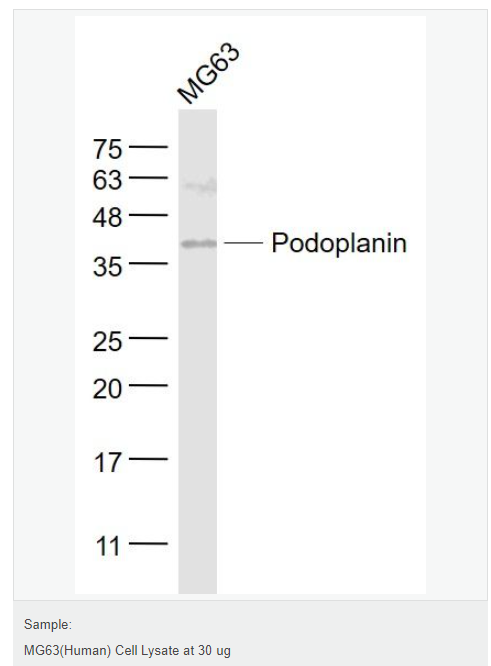

貨號
產品規(guī)格
售價
備注
BN41645R-50ul
50ul
¥1486.00
交叉反應:Human(predicted:Mouse,Rat) 推薦應用:WB,ELISA
BN41645R-100ul
100ul
¥2360.00
交叉反應:Human(predicted:Mouse,Rat) 推薦應用:WB,ELISA
BN41645R-200ul
200ul
¥3490.00
交叉反應:Human(predicted:Mouse,Rat) 推薦應用:WB,ELISA
產品描述
| 英文名稱 | Podoplanin |
| 中文名稱 | 平足蛋白/淋巴管內皮細胞蛋白抗體 |
| 別 名 | Podoplanin Protein; AGGRUS; GLYCOPROTEIN 36 KD; Podoplanin; Glycoprotein 36; gp 36; GP 38; GP 40; gp36; GP38; GP40; HT1A 1; HT1A1; hT1alpha1; hT1alpha2; Lung type I cell membrane associated glycoprotein; Lung type I cell membrane associated glycoprotein isoform a; Lung type I cell membrane associated glycoprotein T1A 2; OTS 8; OTS8; OTTHUMP00000009640; OTTHUMP00000044504; PA2.26; PA2.26 antigen; PDPN; Podoplanin; T1 alpha; T1 ALPHA GENE; T1A; TIA 2; TIA2. |
| 研究領域 | 腫瘤 心血管 細胞生物 免疫學 血管內皮細胞 淋巴細胞 |
| 抗體來源 | Rabbit |
| 克隆類型 | Polyclonal |
| 交叉反應 | Human, |
| 產品應用 | WB=1:500-2000 ELISA=1:5000-10000 not yet tested in other applications. optimal dilutions/concentrations should be determined by the end user. |
| 分 子 量 | 15kDa |
| 細胞定位 | 細胞膜 |
| 性 狀 | Liquid |
| 濃 度 | 1mg/ml |
| 免 疫 原 | KLH conjugated synthetic peptide derived from human Podoplanin:31-130/166 |
| 亞 型 | IgG |
| 純化方法 | affinity purified by Protein A |
| 儲 存 液 | 0.01M TBS(pH7.4) with 1% BSA, 0.03% Proclin300 and 50% Glycerol. |
| 保存條件 | Shipped at 4℃. Store at -20 °C for one year. Avoid repeated freeze/thaw cycles. |
| PubMed | PubMed |
| 產品介紹 | This gene encodes a type-I integral membrane glycoprotein with diverse distribution in human tissues. The physiological function of this protein may be related to its mucin-type character. The homologous protein in other species has been described as a differentiation antigen and influenza-virus receptor. The specific function of this protein has not been determined but it has been proposed as a marker of lung injury. Alternatively spliced transcript variants encoding different isoforms have been identified. [provided by RefSeq, Jul 2008] Function: May be involved in cell migration and/or actin cytoskeleton organization. When expressed in keratinocytes, induces changes in cell morphology with transfected cells showing an elongated shape, numerous membrane protrusions, major reorganization of the actin cytoskeleton, increased motility and decreased cell adhesion. Required for normal lung cell proliferation and alveolus formation at birth. Induces platelet aggregation. Does not have any effect on folic acid or amino acid transport. Does not function as a water channel or as a regulator of aquaporin-type water channels. Subcellular Location: Membrane; Single-pass type I membrane protein. Cell projection, filopodium membrane; Single-pass type I membrane protein. Cell projection, lamellipodium membrane; Single-pass type I membrane protein. Cell projection, microvillus membrane; Single-pass type I membrane protein. Cell projection, ruffle membrane; Single-pass type I membrane protein. Note=Localized to actin-rich microvilli and plasma membrane projections such as filopodia, lamellipodia and ruffles. Tissue Specificity: Highly expressed in placenta, lung, skeletal muscle and brain. Weakly expressed in brain, kidney and liver. In placenta, expressed on the apical plasma membrane of endothelium. In lung, expressed in alveolar epithelium. Up-regulated in colorectal tumors and expressed in 25% of early oral squamous cell carcinomas. Post-translational modifications: Extensively O-glycosylated. Contains sialic acid residues. O-glycosylation is necessary for platelet aggregation activity. The N-terminus is blocked. Similarity: Belongs to the podoplanin family. SWISS: Q86YL7 Gene ID: 14726 Database links: Entrez Gene: 10630 Human Entrez Gene: 14726 Mouse Omim: 608863 Human SwissProt: Q86YL7 Human SwissProt: Q62011 Mouse Unigene: 468675 Human Unigene: 2976 Mouse Unigene: 794 Rat Important Note: This product as supplied is intended for research use only, not for use in human, therapeutic or diagnostic applications. |

